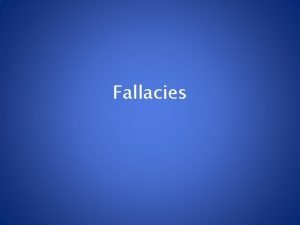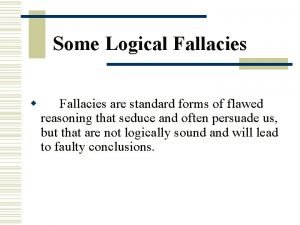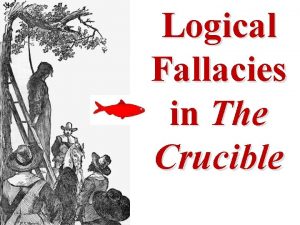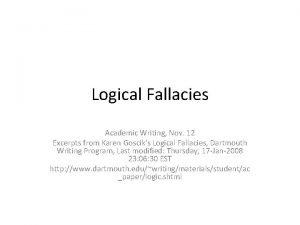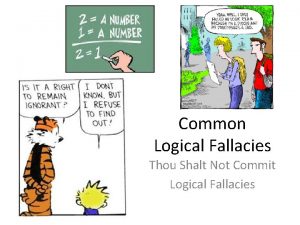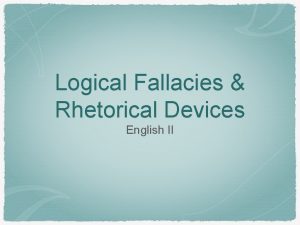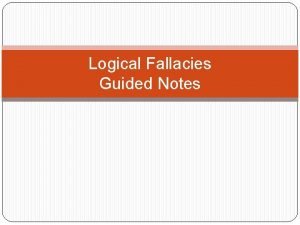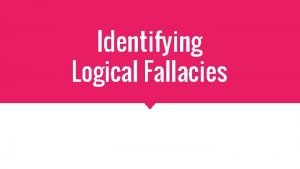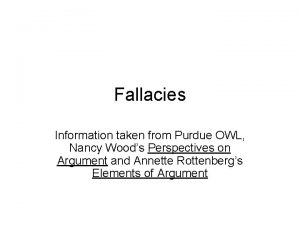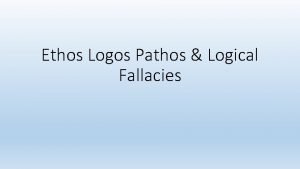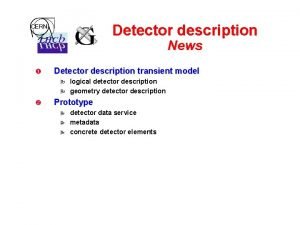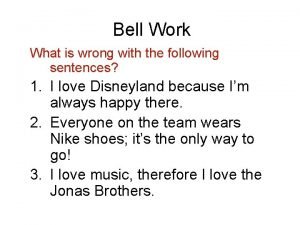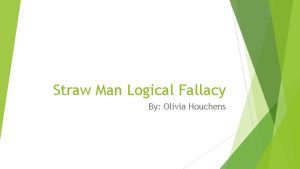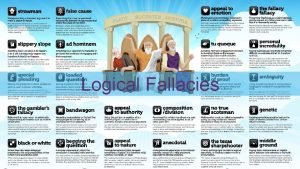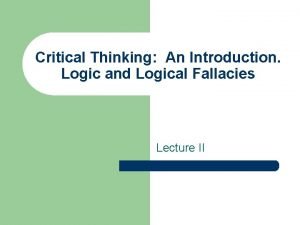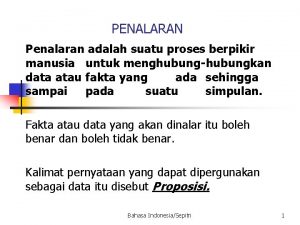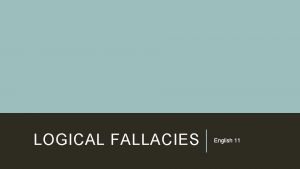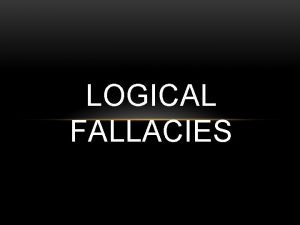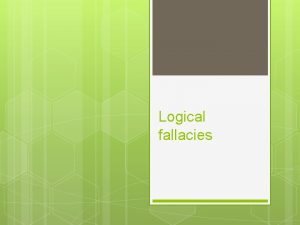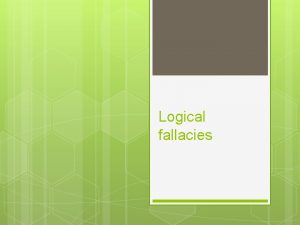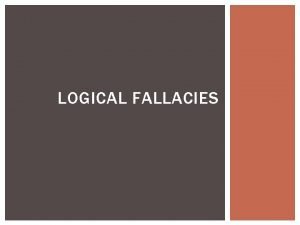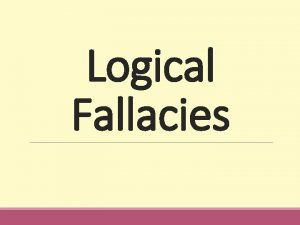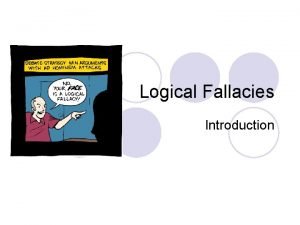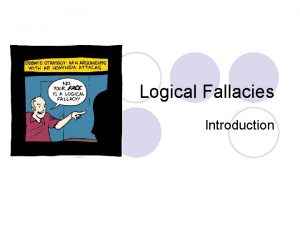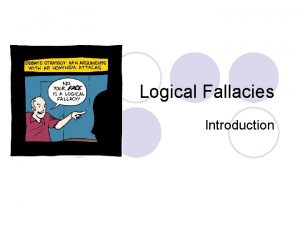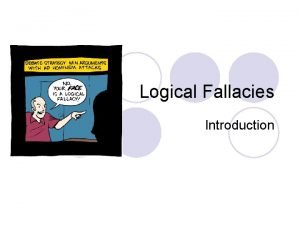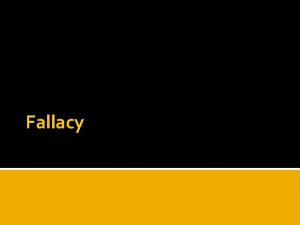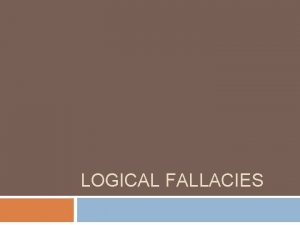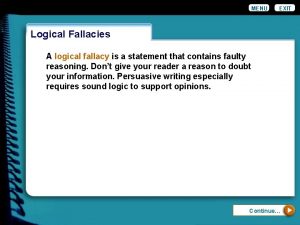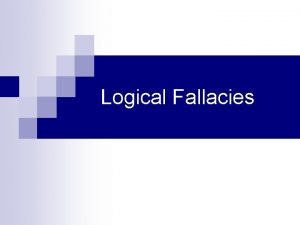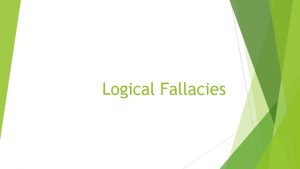Logical Fallacies Introduction What is a logical fallacy


















- Slides: 18

Logical Fallacies Introduction

What is a logical fallacy? l A fallacy is an error of reasoning. These are flawed statements that often sound true. l Logical fallacies are often used to strengthen an argument, but if the reader detects them the argument can backfire, and damage the writer’s credibility.

Origins l The word “fallacy” derives from the Latin word fallere meaning, “to deceive, to trip, to lead into error or to trick. ” The word also derives from the Greek phelos, meaning “deceitful. ” www. sun-design. com/talitha/fallacies. htm

Why study logical fallacies? l It is important to develop logical fallacy detection skills in your own writing, as well as others’. Think of this as “intellectual kung-fu: the art of intellectual self defense. ” (Logical Fallacies Handlist)

Types of Logical Fallacies The following slides will briefly explain 15 fallacious arguments. All fallacies fit in 3 categories a) Not enough supportive information b) Invalid/inaccurate information c) Too much distracting information

Types of Logical Fallacies - 1. “Bandwagon Approach” - “It must be cool because everyone is doing it… - “ 90 percent of computer users choose Macs” - (sometimes called Appeal to Popularity)

Types of Logical Fallacies - 2. “Slippery Slope” - a fallacious argument built on the supposition that a small step will lead to a larger chain of events “If you submit one late homework assignment then you will never graduate high school. ”

3) Appeals to Authority l Using a celebrity or authority figure’s name to support an issue which if not really his or her expertise. l “Katie Perry thinks the killer should be pardoned. ” FALSE AUTHORITY. l Often called. . . Using a suspicious, incredible source to defend a conclusion

Types of Logical Fallacies l 4. ) Card Stacking l Considered a fallacy of omission - Material is simply left out or taken out of context, ignoring evidence that doesn’t support your opinion

5) Hasty Generalizations l This is the chief error in reasoning! – a type of inductive reasoning – conclusions made through insufficient evidence Ex: The man who hit my car was 35 years old. All 35 year-olds are reckless drivers.

Fallacies, continued. . . 6) Begging the question: “Situation A” is true because “Situation A” is true. . . “Chocolate is healthy because it is good for you. ” 7) Straw Man: a fallacy of distraction – an irrelevant conclusion (Ex: How could she be a good class president? She has purple hair!)

More Fallacies l 8) Appeals to Pity: appealing to someone’s emotions in order to distract them from the truth. This Photo by Unknown Author is licensed under CC BY-SA-NC

l 9) Ad Hominem: Latin for “To the man” – pointing out a negative characteristic to support one’s argument (ex: How could students elect public officials? They are too young to know what is important!) This Photo by Unknown Author is licensed under CC BY-NC-ND

l 10) Non sequitur: conclusion doesn’t logically follow the premise: (Paper is flammable and can be used to cover grocery items. Therefore, paper is plastic. )

l 11) Guilt by association: a false correlation between two events (9/11 Sandy Hook shooting) l 12) Faulty Cause/effect: Ex: “we’ve been in business 50 years – That makes us the best! l 13) False needs: “If parents want intelligent children, they must buy Baby Mozart!”

l 14) Either/Or fallacy – aka False Dilemma. . . “You’re either part of the solution or part of the problem” l You can be financially stable or you can be happy.

15. ) Post Hoc l The arguer infers that because one event follows another, the first event must be the cause of the second event. l Causation without correlation l Ex: The rooster crowed, the sun came up. Therefore, the rooster made the sun come up.

In conclusion, always be on the lookout for faulty reasoning! If you took notes and completed the activity, you are a genius! Congratulations!
 Appeal to vanity fallacy
Appeal to vanity fallacy Unqualified generalization
Unqualified generalization Logical fallacies in the crucible
Logical fallacies in the crucible Fallacies in academic writing
Fallacies in academic writing Thou shalt not commit logical fallacies image
Thou shalt not commit logical fallacies image Rhetorical devices and logical fallacies
Rhetorical devices and logical fallacies Logical fallacies guided notes
Logical fallacies guided notes Logical fallacy referee
Logical fallacy referee Ad populum fallacy
Ad populum fallacy Ethos pathos logos quiz
Ethos pathos logos quiz Logical fallacies detector
Logical fallacies detector Logical fallacies bell ringer journal
Logical fallacies bell ringer journal Logical fallacies in thank you for smoking
Logical fallacies in thank you for smoking Either or fallacy
Either or fallacy Examples of dogmatism fallacy
Examples of dogmatism fallacy Texas sharpshooter fallacy
Texas sharpshooter fallacy Logical fallacies
Logical fallacies Contoh silogisme kategorik
Contoh silogisme kategorik False dilemma
False dilemma
